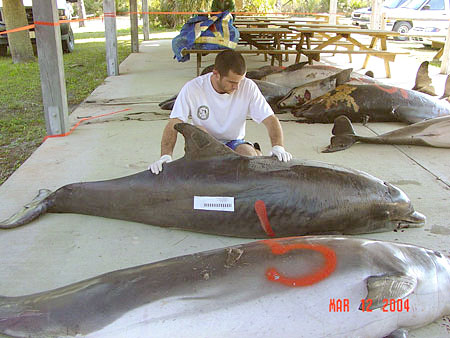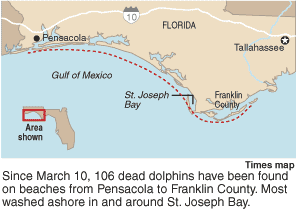Disclaimer: These postings were sent to us from a variety of media sources over the Internet. The content has not been reviewed for scientific accuracy or edited in any manner.
Dolphin deaths still a mystery
Published April 2, 2004
 Just before sunset on March 10, wildlife rehabilitator Barbara Eells
discovered a dead bottlenose dolphin lying on a deserted beach at St.
Joseph's Bay in the Florida Panhandle.
Just before sunset on March 10, wildlife rehabilitator Barbara Eells
discovered a dead bottlenose dolphin lying on a deserted beach at St.
Joseph's Bay in the Florida Panhandle.
A half-hour later, she spotted a second dead dolphin. Then a third.
"Uh-oh," Eells said to herself. "I hope this isn't the beginning."
But it was.
Since Eells made her grisly discovery, 103 more dolphin carcasses have washed ashore along Panhandle beaches. The most recent was found Sunday.
What's killing them is a mystery that has sparked an investigation involving nearly a dozen state and federal agencies. Necropsies have been performed. Blood and urine tests taken.
Toxicology tests are still pending, but experts say they have found evidence of Karenia brevis, a toxin produced by Red Tide algae, in the dolphins' bodies.
Yet no Red Tide bloom has been found in the Gulf of Mexico.
"That's the big mystery," said Leanne Flewelling, marine research associate at the Florida Marine Research Institute in St. Petersburg. "There must be either currently or recently a bloom up that way that we just missed," Flewelling said. "Maybe it's sub-surface and we weren't able to detect it."
Red Tide is a higher-than-normal concentration of a naturally occurring algae that can kill fish and other marine life while causing respiratory problems for people. Fish die after sucking the toxic particles through their gills and into their bloodstream; dolphins then eat the fish and become sick and die.
 "Somewhere adjacent to the shore along the Gulf, something happened,"
Eells said. "Whatever it was killed these dolphins while they were
eating. Their stomachs were full."
"Somewhere adjacent to the shore along the Gulf, something happened,"
Eells said. "Whatever it was killed these dolphins while they were
eating. Their stomachs were full."
The Gulf of Mexico is home to 26 different kinds of dolphin species. Most people along Florida's Gulf Coast usually spot the most common kind, the bottlenose dolphin.
The dolphins have been living offshore. Researchers are trying to determine if the dolphins migrated, and where they were headed when they died.
Water samples also have been taken from the Gulf from Pensacola to St. Joseph Bay. While no evidence of Red Tide toxin has been found, another harmful algae, Pseudo-nitzschia, was found in the water.
A toxin caused by that algae was also found in the dolphins, said Blair Mase, fisheries stranding coordinator for the National Oceanic and Atmospheric Administration.
"We're suspecting right now that could be a cause," Mase said. "With all the research going on right now, we're closer to solving the mystery than ever before."
Pseudo-nitzschia produces domoic acid, a biotoxin commonly known as the cause of amnesic shellfish poisoning in humans.
That can be a life-threatening syndrome, with gastrointestinal and neurological symptoms. In 1987, four people died after eating toxic mussels from Prince Edward Island in Canada.
Florida has seen large-scale dolphin deaths before. In 1999, about 100 dolphins died near the Panhandle. Red Tide was suspected then, Mase said.
In 1987, viruses affected dolphins along the Atlantic coast and about 700 dolphin carcasses washed ashore from New Jersey to Florida that year.
None of the dolphins had viral infections, she said. A dolphin that recently washed ashore in Pinellas County had some kind of infection, experts say.
That 418-pound dolphin was discovered near the Don CeSar Hotel in St. Pete Beach last week. Rescuers took it to the Mote Marine Laboratory in Sarasota, where it is recovering, Mote said.
Experts say they don't think a wave of dolphin carcasses will wash ashore in Pinellas County because there is no indication of algae blooms.
- Tamara Lush can be reached at 727 893-8612 or at lush@sptimes.com